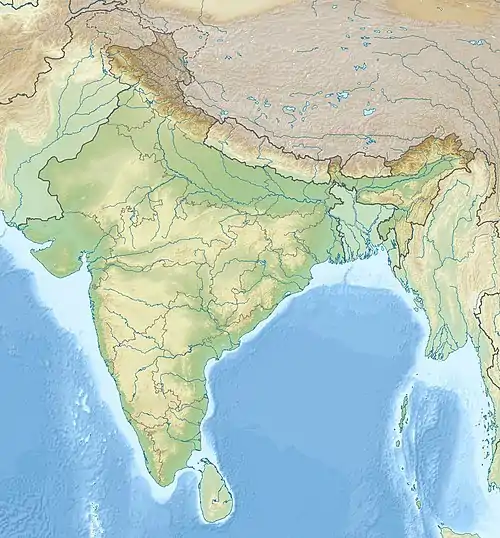Amolops jaunsari
Amolops jaunsari, also known as the Jaunsar stream frog[3][4] or Jaunsar's torrent frog,[5] is a species of frog endemic to India. It is only known from its type locality near Chakrata in Uttarakhand (formerly Uttar Pradesh).[3][4][5] It was described based on a single specimen collected in 1985 and has not been recorded ever since.[4]
| Amolops jaunsari | |
|---|---|
| Scientific classification | |
| Domain: | Eukaryota |
| Kingdom: | Animalia |
| Phylum: | Chordata |
| Class: | Amphibia |
| Order: | Anura |
| Family: | Ranidae |
| Genus: | Amolops |
| Species: | A. jaunsari |
| Binomial name | |
| Amolops jaunsari Ray, 1992[2] | |
 | |
| Amolops jaunsari is only known from near Chakrata in northern India | |
Description
Amolops jaunsari is a relatively small species of Amolops. The head is wider than it is long. The eyes are relatively large. The tympanum is distinct and the supratympanic fold is present. The fingers have distinct terminal discs. The toe discs are similar to the fingers ones. The dorsum is dark olive green. The upper lip has light brown and lighter spots. The iris is golden brown. A blackish band runs from the eye to the sacrum. The limbs have dark and light brown crossbars. The throat and the anterior part of the breast have dark brown mottling.[5]
Habitat and conservation
Amolops jaunsari is a semi-aquatic species that occurs in small hill-streams[5] at an elevation of about 1,062 m (3,484 ft) above sea level.[4] The threats to this poorly-known species are unknown.[1]
References
- Pranjalendu Ray, Sushil Dutta (2004). "Amolops jaunsari". IUCN Red List of Threatened Species. 2004: e.T58211A11748508. doi:10.2305/IUCN.UK.2004.RLTS.T58211A11748508.en. Retrieved 20 November 2021.
- Ray, P. (1992). "Two new hill-stream frogs of the genus Amolops Cope (Amphibia: Anura: Ranidae) from Uttar Pradesh (India)". Indian Journal of Forestry. 15: 346–350.
- Frost, Darrel R. (2019). "Amolops jaunsari Ray, 1992". Amphibian Species of the World: an Online Reference. Version 6.0. American Museum of Natural History. Retrieved 27 April 2019.
- "Wanted species". Lost! Amphibians of India. Department of Environmental Biology, University of Delhi. Retrieved 27 April 2019.
- Venkataraman, K.; Chattopadhyay, A. & Subramanian, K.A., eds. (2013). Endemic Animals of India (Vertebrates). Kolkata: Zoological Survey of India. pp. 235+26 plates. [Amolops chakrataensis: p. 98–99]
